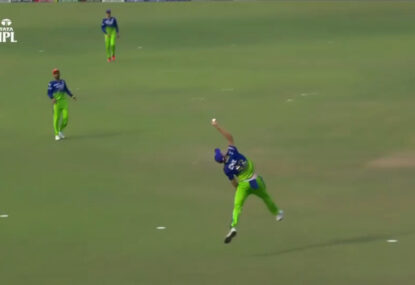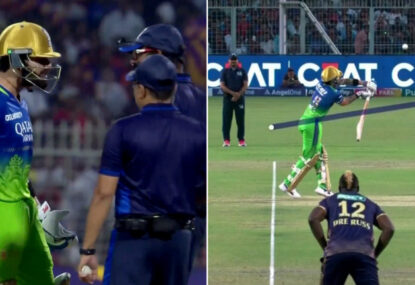With the introduction of Twenty20 cricket, there has been debate about whether administrators can keep three forms of the game alive. The one form of the game that appears vulnerable is the 50-over one day game.
The one dayers have often been described as dour, long and boring compared to it’s younger trendier sibling, Twenty20.
However in recent times, it has enjoyed a renaissance, particularly in the 2013 one day series between India and Australia.
In the seven match series, only five matches were completed due to poor weather. In those completed matches, on nine occasions out of ten innings, 300 plus was scored, with five scores been over 350.
Indian captain MS Dhoni reacted to these high scores by stating that the fast bowlers need to adjust to the new rules, such as with four fielders, instead of five, outside of the 30 yard circle.
“With the extra fielder inside, if you are slightly off target, it goes for a boundary. A few of the bowlers are disappointed, they actually feel it will be better off to put a bowling machine there. It is a new challenge for the bowlers.”
Quite often these days, scores of over 300 have taken place.
Perhaps it is the influence of T20 along with the rule changes such as the introduction of batting power plays and with many grounds having smaller boundaries by simply bringing in the rope.
The first one day international was played on January 5, 1971. The match occurred when the third Test between Australia and England was abandoned after the first three days were washed out.
Australia and England played in a match that consisted of 40 overs per side (eight ball overs). Australia won the game by five wickets.
The first three world cups (1975, 1979 and 1983) were all held in England. In all three world cups, matches were contested of 60 overs a side.
But when India and Pakistan hosted the tournament in 1987, the overs were reduced from 60 to the current 50.
I remember following the one dayers in the early nineties. There were fielding restrictions where there were two men outside of the 30 yard circle in the first 15 overs. After 15 overs, the fielding side was allowed to have five fielders outside of the circle.
The one team that started playing with real flair in the first 15 overs was Sri Lankan opening pair Sanath Jayasuriya and Romesh Kaluwitharana. Many teams during that era would start with caution and preserve their wickets.
However with Jayasuriya and Kaluwitharana, they both had a licence to go after the bowling in the first 15 overs.
It was this key tactic that helped Sri Lanka win the 1996 world cup.
After ’96, many countries decided to adopt Sri Lanka’s strategy over going over the top in the first 15 overs. An example of that was Australia putting big hitting wicketkeeper batsman Adam Gilchrist in the opening position.
From there, many teams would start attacking in the first 15 overs.
When the fan fare died down after the first 15 overs, teams would slowly go about their business by picking up one’s and two’s from overs 15 to 40 and going about at five an over with out minimal risk.
You also had the fifth and/or sixth bowlers been used during this period after the four main bowlers ( five bowlers can only bowl 10 overs each at a maximum ) were used earlier.
Those bowlers would either be allrounders or part timers. It was during this period where it became dour and boring.
To offset this, new rules came into play in 2005. In the first 10 overs, only two fielders were allowed outside the circle. There was an introduction of the two five over powerplays.
One powerplay for the bowling side to use at it’s discretion, while the other powerplay was used by the batting side. The powerplays meant, only three fieldsmen were allowed outside the circle.
Today, the bowling powerplay has been shelved, but the batting powerplay still remains.
One key rule change in todays game, is that outside of the first 10 overs and the batting powerplay, for the other remaining 35 overs, the fielding side is only allowed four fielders outside the 30 yard circle, instead of the five which is a massive change.
It gives the batting side in the last ten overs in particular, to aim for the space outside of the circle where normally the fifth fielder would be.
It is all well and good to make these rule changes to help improve the spectacle of one day cricket. However, I somehow think that these rule changes have favoured the batsman.
Therefore the contest between bat and ball becomes non existent. Hence, regular scores of over 300.
One change the ICC could bring in my opinion is to reduced the amount of overs from 50 to 40.
Even if it’s 40 overs a side, you would still term it a one day international. Also as I mentioned earlier, the very first ODI was a 40 over a side game. Back to the future perhaps?
In a 40 over innings, here are some of my rule changes.
Have the first 15 overs with two men outside of the circle, just like it was in the past, and for the remaining 25 overs, have five fielders outside of the 30 yard circle.
Also have your four main bowlers bowl 10 overs a piece at a maximum if required to make up the 40 overs, rather then go with five bowlers at eight overs each with the fifth bowler been an “allrounder” or “part timer”.
The only time a part timer be required to bowl, is when the main bowlers become expensive.
The point I’m making is, I don’t like seeing part timers been the fifth bowler, and that between them, they may have to bowl ten overs.
I’m not suggesting that every team should pick four main/specialist bowlers. A team could be picked where every player can bat or bowl if possible.
But traditionally, in one day cricket, the bowling attack would have a pattern of two fast bowlers bowling in the first 8 to 10 overs.
Then at first change, a main seamer or a fast bowling allrounder comes on to bowl.
While in the middle overs, the main spin bowler and a part timer would come into the attack. While in the latter overs, the captain brings back his fast bowlers.
Twenty/20 has been noted for been the “Big Bash”, full of ‘fours” and ”sixers”, while with one dayers, teams have to be methodical in the middle overs before attacking in the last 10 to 15 overs.
With 40 over cricket, you could have the right balance. Teams go hard in the first 15 overs, consolidate in the next 10 to 15, then start an assault towards the last 10 or so overs.
The game wouldn’t drift, and if you had your four main bowlers, rather then part timers, it then allows a good contest between bat and ball.
Hypothetically, if the ICC came up with the move of reducing to 40 overs in one dayers more then ten years ago, then maybe there wouldn’t be the introduction of Twenty20.
In the last few years, in English county cricket, they have had the Pro40 and today the ECB 40 competitions.
Interestingly, this year they are reverting back to 50 overs. Could it be due to the fact that England is ranked fourth in the 50 over format?
However, the question remains, how long will 50 over ODIs last?
Will it be around in 20 years time?
If the answer is no, then will ODIs be reduced to 40 overs, or will cricket only have the Tests and Twenty20?
Time will tell.





































































































